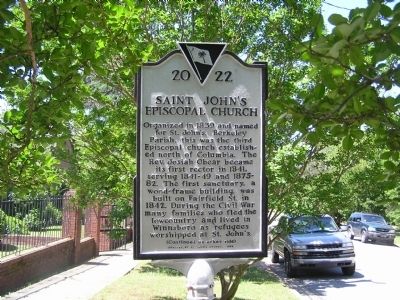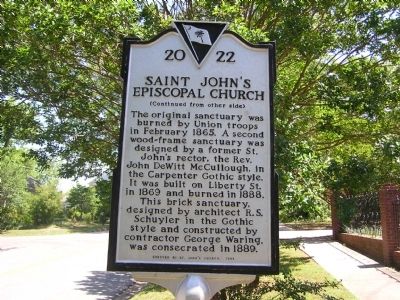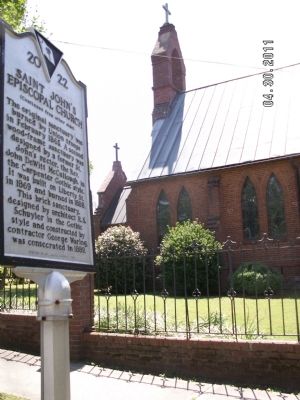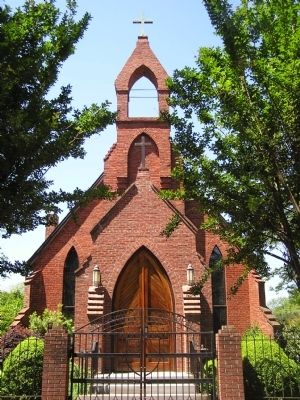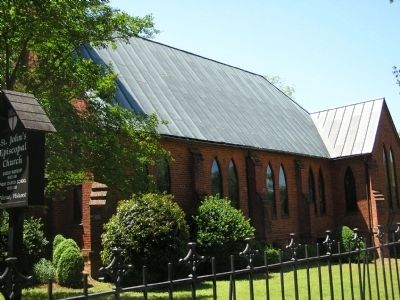Winnsboro in Fairfield County, South Carolina — The American South (South Atlantic)
Saint John's Episcopal Church
Organized in 1839 and named for St. John's, Berkeley Parish, this was the third Episcopal church established north of Columbia. The Rev. Josiah Obear became its first rector in 1841, serving 1841-49 and 1875-82. The first sanctuary, a wood-frame building, was built on Fairfield St. in 1842. During the Civil War many families who fled the lowcountry and lived in Winnsboro as refugees worshipped at St. John's.
(Reverse):
The original sanctuary was burned by Union troops in February 1865. A second wood-frame sanctuary was designed by a former St. John's rector, the Rev. John DeWitt McCullough, in the Carpenter Gothic style. It was built on Liberty St. in 1869 and burned in 1888. This brick sanctuary, designed by architect R.S. Schuyler in the Gothic style and constructed by contractor George Waring, was consecrated in 1889.
Erected 1999 by St. John's Church. (Marker Number 20-22.)
Topics. This historical marker is listed in these topic lists: Churches & Religion • War, US Civil. A significant historical month for this entry is February 1865.
Location. 34° 22.657′ N, 81° 5.358′ W. Marker is in Winnsboro, South Carolina, in Fairfield County. Marker is at the intersection of West Liberty Street and South Gadsden Street , on the left when traveling west on West Liberty Street. Touch for map. Marker is at or near this postal address: 301, Winnsboro SC 29180, United States of America. Touch for directions.
Other nearby markers. At least 8 other markers are within walking distance of this marker. Cathcart-Ketchin House / Catharine Ladd (approx. 0.2 miles away); Fairfield County Courthouse (approx. ¼ mile away); Fairfield County / Winnsboro (approx. ¼ mile away); Town Clock (approx. ¼ mile away); Fairfield Institute / Kelly Miller (approx. 0.3 miles away); William Porcher Dubose (approx. 0.3 miles away); Bethel Church (approx. 0.3 miles away); James Henry Carlisle (approx. 0.4 miles away). Touch for a list and map of all markers in Winnsboro.
Additional commentary.
1. Saint John's Episcopal Church History
By the mid-l820's worship services were periodically conducted in Winnsboro by Episcopal missionaries to the South Carolina backcountry.
After the arrival in Fairfield District in the 1830's of several lowcountry planter families, St. John’s Church, Fairfield was organized in 1839 as a mission church.
Named for St. John’s Berkeley Parish, services were conducted by the Rev. Cranmore Wallace, an Episcopal Missionary assigned to the “destitute parishes and other places,” of which Fairfield District was a part.
The Rev. Josiah Obear of Vermont came to Winnsboro in May of 1841 as the first rector of St. John’s. The following year the congregation erected a small frame church on Fairfield Street at the site of the present church cemetery. Dedicated by Bishop Gadsden on September 28, 1842, it was the third Episcopal Church to be built north of Columbia. This church was burned by Union Troops on February 21, 1865.
By 1866 the parishioners had made plans to rebuild the church on Liberty Street. Gothic in architectural style, the second church was consecrated by Bishop Davis on July 25, 1869. The sermon was delivered by the Rev. William Porcher Dubose, Rector of St. John’s from 1865 to 1867. On March 1, 1888 the second church was also destroyed by fire.
The corner of Liberty and Garden Streets was then selected as the site for the present church. On November 2, 1888, Bishop Howe laid the cornerstone of the present Gothic style brick church. It was designed by architect R. S. Schyler and built by George Waring. The first service in this church was conducted by the Rev. James G. Glass on March 20, 1889. It was consecrated on April 19, 1894. At the consecration, Bishop Capers both preached the sermon and celebrated Holy Communion.
The present Rectory was built in 1921 on lot adjoining the church. A Parish Hall was added to the Sanctuary in 1954 and the Narthex was added to the front of the church in 2000.
— Submitted September 25, 2011, by Anna Inbody of Columbia, South Carolina.
2. Church burning in 1865
There are diary entries of private Winnsboro citizens and 22nd Wisconsin Corps officers which state that St. John's Episcopal Church was burned by retreating Confederate soldiers who were looking for gold, alleged to be stored on the grounds, and not by Union soldiers.
— Submitted April 12, 2015.
Credits. This page was last revised on June 16, 2016. It was originally submitted on September 25, 2011, by Anna Inbody of Columbia, South Carolina. This page has been viewed 1,039 times since then and 34 times this year. Photos: 1, 2, 3, 4, 5. submitted on September 25, 2011, by Anna Inbody of Columbia, South Carolina. • Craig Swain was the editor who published this page.
